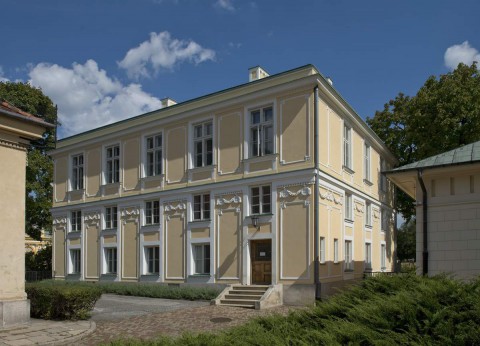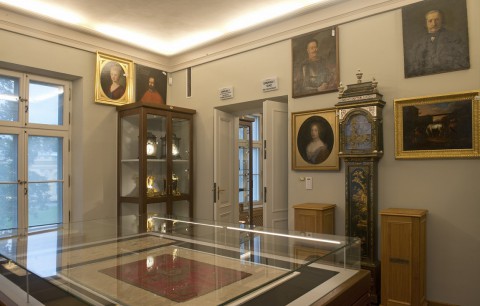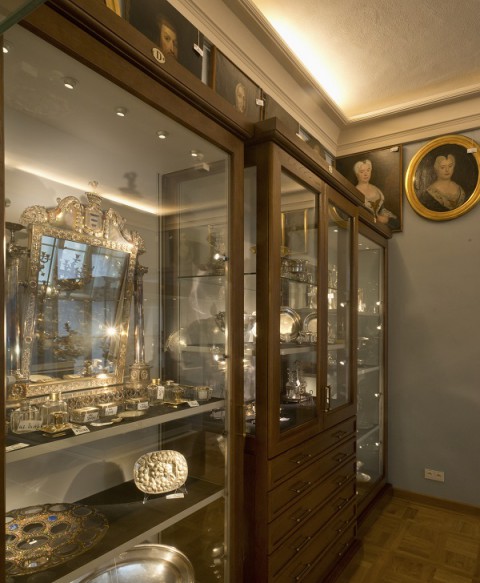Storage Accessible for Visitors
The Storage Accesible for Visitors is an exhibition area created in Markoniówka – a small, three-storey building adjacent to the south wing of the palace. The original storeyed building was erected, by order of Princess Izabela Lubomirska, by Szymon Bogumił Zug, in the years 1775-1778, as a bathroom pavilion. The pavilion’s apartments were connected to the Princess’s rooms located in the palace wing. In the 20th century the pavilion was rebuilt and extended to the shape it has today.
The unique character of the exhibition in the Storage accesible for visitors facilitates the presentation of valuable works of art, which, for many reasons, have not been put on display for a number of years. It houses an exclusive collection of a goldsmith’s wares, original wall fabrics from the royal apartments, and a collection of Far Eastern artwork, containing works decorated with several types of lacquer, enamel metal dishes, a rich collection of china, and watercolour paintings on paper.
The modern space of the pavilion is equipped with specially designed display cabinets allowing visitors to see the delicate exhibits at a very short distance.
The opening of the museum storage to the public allows one to see artefacts which were previously unavailable, required special exhibition conditions, or were awaiting or undergoing conservation. A visit to the museum storage affords a unique opportunity to admire artwork from a perspective previously unavailable.
The exhibits housed in the gallery, made of expensive metals such as silver, gold-plated silver and gold-plated bronze, were ornaments to the house, and demonstrated its owner’s wealth and taste. Due to the high value of the articles, not many of those luxurious items have remained. Because of a sudden need to raise cash, or even through changing fashions, such valuable articles were often remelted into something else. An inventory taken after the death of Jan Sobieski demonstrates the King’s impressive collection of 400 silver dishes and table ornaments made in the most eminent European workshops, in Augsburg, Gdańsk, and Nuremberg, to name but a few. To the next owners of Wilanów we owe the magnificent collection of Empire-style French silverware and bronze artefacts crafted in the workshops of the greatest Parisian masters, suppliers to the Emperor’s court.
In addition to goldsmith’s artworks, in the gallery one can also see the raw materials and semi-finished products from which such artworks are made, as well as the tools for forming them, using techniques such as forging, repoussage and moulding.
The original wall fabrics from the royal apartments were most probably made in Italy in the before 1730s by order of the second owner of the Wilanów residence, Elżbieta Sieniawska. Velours de Gênes fabrics adorned the walls of the antechambers, the royal couple’s bedroom, and the Dutch Cabinet. The changeable climatic conditions over dozens of years had a destructive effect on the condition of those velours in some apartments. Some of them were taken down and replaced with copies made using the same techniques and materials as the 18th-Century originals. In the display cabinets of the Storage visitors can see the velours from the Dutch Cabinet and the King’s Bedroom, and also learn about the process through which these fabrics are made.
The exhibition at the Storage also includes a large collection of Far Eastern artwork. Most of it comes from the 18th century, which is why, as it harks back to the times of Jan III, it did not entirely match the exhibition in the royal apartments. Such a large and varied collection needed special exhibition space. The placing of the oriental artefacts in the Storage is also connected with their condition. Works made of fragile china or coated with expensive lacquer, as well as photosensitive and delicate watercolour paintings on paper, require special exhibition and storage conditions – with optimal lighting, temperature and humidity. This also applies to recently restored artefacts, so that they can be preserved in the best condition. In order to ensure the most-favourable conditions for the collection, the exposition of the Japanese lacquer will be changed every three months, since it is the longest permissible duration of its exposition to light.
The collection of weaponry features examples of cold steel, including Turkish sabres made of hard and resilient Damascus steel. Their hilts are often adorned with gold, silver or mother-of-pearl. The ornaments on the sabre and the sheath showed the rank of their owner. The gallery also exhibits examples of firearms – harquebuses encrusted with ivory into twigs, and representations of hunting scenes, and an Egyptian Janissary sabre adorned with carved floral ornaments and coral.
The Wilanów clock collection, exhibited both at the Storage accessible for visitors and in a great many palace interiors, can be classified in several ways. One division takes into account the place in which clocks used to be presented. This gives rise to terms such as console clock, table clock, floor clock or mantel clock.
suggested

History of the palace
The Wilanów Palace was established at the behest of King Jan III as his suburban summer residence. The building was …

History of the museum
The museum at the Wilanów palace is the oldest Polish museum of art. It was established in 1805, on the …

3D documentation of selected collections
The project “Rendering the Palace collections in 3D” covered two different categories of activities carried out on two distinct groups …



















